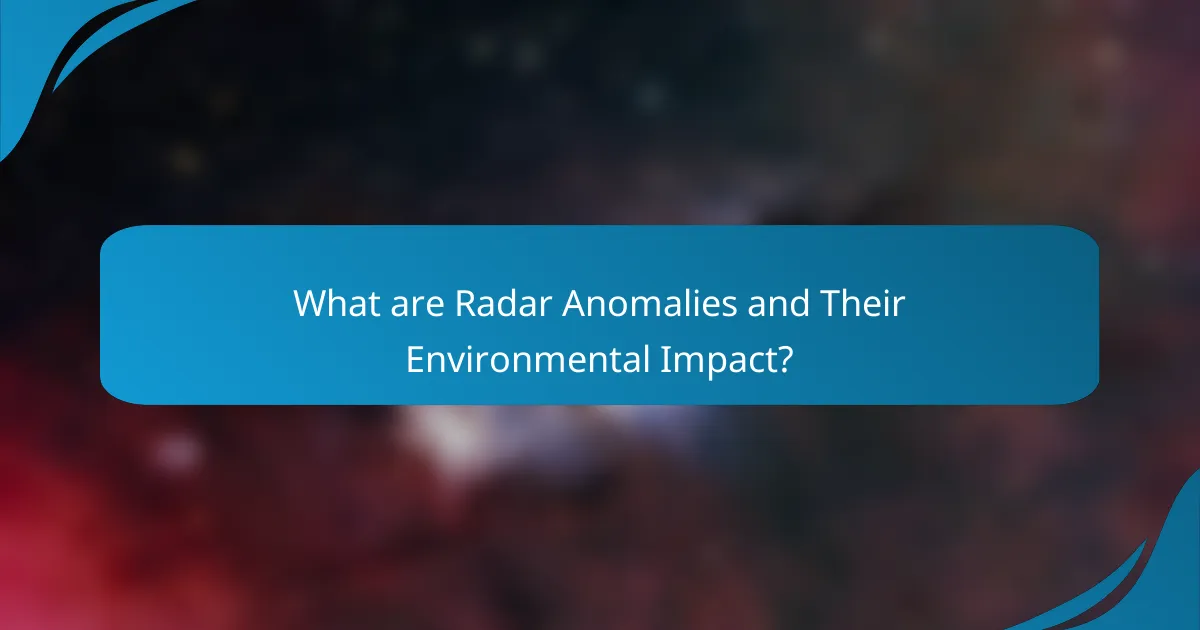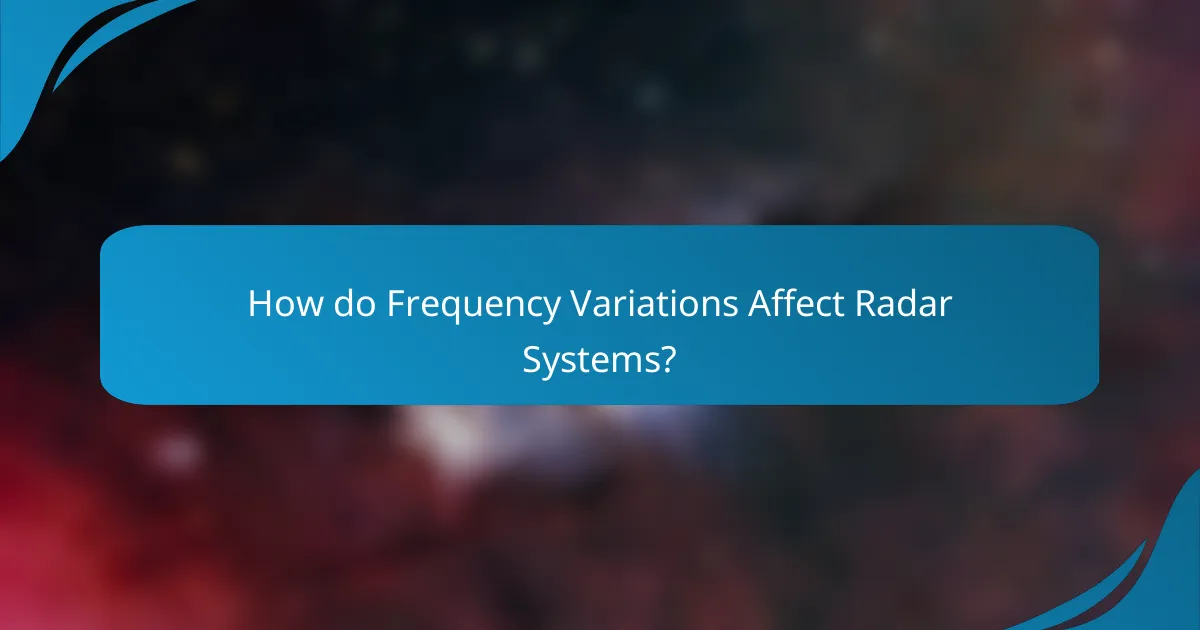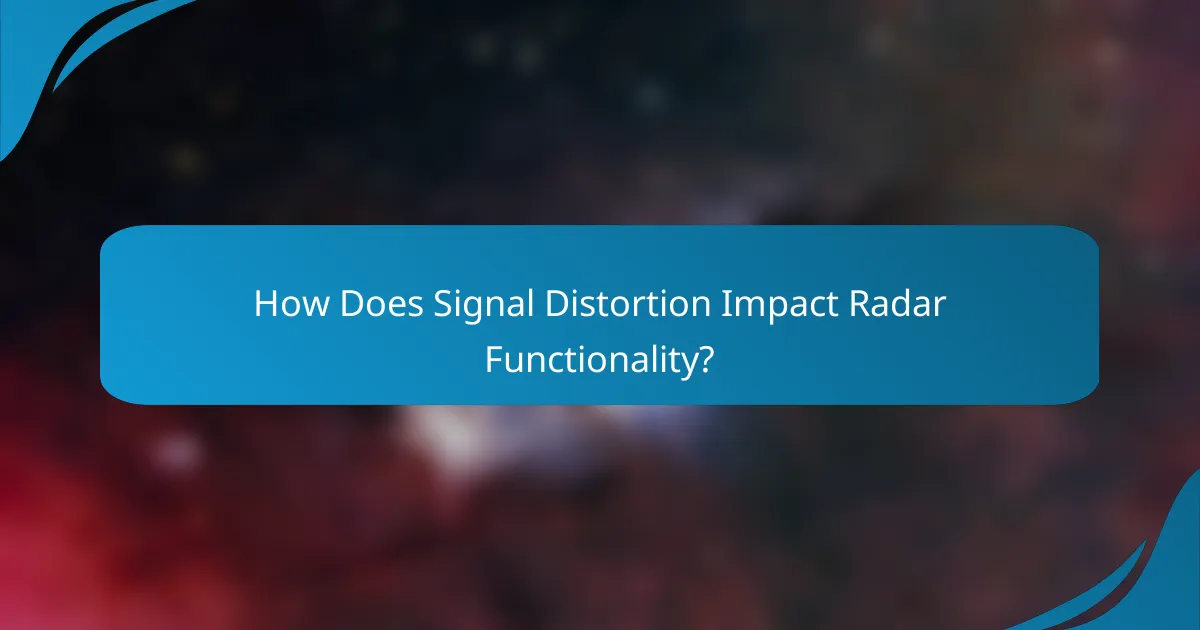Radar anomalies are unexpected variations in radar signals influenced by environmental factors such as atmospheric conditions, terrain, and physical obstructions. These anomalies can lead to significant inaccuracies in radar readings, particularly during adverse weather, impacting both weather forecasting and aviation safety. Additionally, frequency variations can alter signal propagation, affecting detection accuracy and target velocity readings. Signal distortion further complicates radar functionality by degrading signal quality, resulting in false alarms and missed detections. This article examines how these environmental factors, including frequency changes and signal distortion, compromise radar system reliability across various applications.

What are Radar Anomalies and Their Environmental Impact?
Radar anomalies are unexpected variations in radar signals that can be caused by environmental factors. These anomalies can result from atmospheric conditions, terrain, and other physical obstructions. For example, heavy rain or snow can scatter radar waves, leading to inaccurate readings. Additionally, temperature inversions can create false targets on radar displays. The environmental impact of these anomalies can affect weather forecasting and aviation safety. Studies have shown that radar accuracy decreases significantly in adverse weather conditions. This can lead to misinterpretations of storm systems and potentially hazardous situations for aircraft.
How do environmental factors contribute to radar anomalies?
Environmental factors contribute to radar anomalies by affecting signal propagation and reflection. Atmospheric conditions, such as humidity and temperature, can alter the refractive index of air. This leads to bending or scattering of radar waves. Terrain features, like mountains and buildings, can obstruct signals and create multipath effects. Additionally, precipitation can absorb and attenuate radar signals. These interactions can result in false targets or signal distortion. Studies show that radar performance can degrade significantly in adverse weather conditions. For example, heavy rain can reduce radar range and accuracy by up to 50%.
What specific environmental factors affect radar signal integrity?
Environmental factors that affect radar signal integrity include precipitation, atmospheric conditions, terrain, and electromagnetic interference. Precipitation, such as rain or snow, can attenuate radar signals, leading to reduced detection ranges. Atmospheric conditions like humidity and temperature inversions can cause signal refraction, altering the expected path of the radar waves. Terrain features, including mountains and buildings, can create shadowing effects, obstructing signals. Electromagnetic interference from other electronic devices or natural sources can introduce noise, compromising signal clarity. These factors collectively influence radar performance and reliability in various operational environments.
How do temperature and humidity variations influence radar performance?
Temperature and humidity variations significantly influence radar performance. High temperatures can cause the radar signal to refract differently, affecting detection range. Increased humidity can lead to signal attenuation, diminishing radar effectiveness. These environmental factors alter the propagation of radio waves. For instance, radar systems operating in humid conditions may experience a reduction in signal strength by up to 20%. Additionally, temperature inversions can create unexpected radar returns. This phenomenon can mislead operators regarding the location of targets. Understanding these effects is crucial for optimizing radar operations.
What are the types of radar anomalies caused by environmental factors?
Radar anomalies caused by environmental factors include ground clutter, precipitation scatter, and ducting effects. Ground clutter occurs when radar signals reflect off stationary objects like buildings or trees. This can lead to false targets appearing on radar displays. Precipitation scatter happens when raindrops or snowflakes scatter radar signals, causing signal distortion. Ducting effects occur due to temperature inversions, allowing radar waves to travel further than usual. These anomalies can significantly affect radar performance and target detection accuracy.
What is frequency variation and how does it occur?
Frequency variation refers to the changes in the frequency of a signal over time. This phenomenon occurs due to various factors, including environmental influences and signal processing techniques. For instance, radar signals can experience frequency shifts caused by atmospheric conditions, such as temperature and humidity changes. Doppler effects, resulting from the relative motion between the radar and the target, also contribute to frequency variation. Additionally, interference from other signals can alter frequency characteristics. These factors collectively lead to discrepancies in the expected signal frequency, impacting radar performance and accuracy.
What is signal distortion and what causes it?
Signal distortion refers to the alteration of a signal’s original shape or characteristics during transmission. It occurs when the signal experiences interference, attenuation, or non-linearities in the transmission medium. Factors such as noise, multipath propagation, and bandwidth limitations contribute to signal distortion. Environmental conditions, like temperature and humidity, can also impact signal integrity. Understanding these causes is crucial for improving communication systems and radar performance.

How do Frequency Variations Affect Radar Systems?
Frequency variations impact radar systems by altering signal propagation and detection accuracy. Changes in frequency can lead to Doppler shifts, affecting target velocity readings. Higher frequencies provide better resolution but are more susceptible to atmospheric attenuation. Lower frequencies penetrate obstacles better but may result in lower resolution. Variations can also cause multipath interference, complicating signal interpretation. Research shows that frequency diversity can enhance radar performance in cluttered environments. Studies indicate that adaptive frequency selection improves target detection rates.
What are the implications of frequency variations on radar accuracy?
Frequency variations can significantly impact radar accuracy. Changes in frequency affect the radar’s ability to detect and track objects. Higher frequencies typically provide better resolution but have limited range. Conversely, lower frequencies can penetrate obstacles but may result in lower resolution. Variations in frequency can lead to Doppler shifts, causing errors in speed measurements. Environmental factors, such as atmospheric conditions, can also alter the effective frequency, impacting signal integrity. Accurate calibration is essential to mitigate these effects. Studies show that frequency stability is crucial for maintaining radar performance in diverse conditions.
How does frequency drift impact target detection?
Frequency drift negatively impacts target detection by altering the frequency of the received signal. This change can lead to mismatches between the radar system’s expected frequency and the actual frequency of the target echo. Such mismatches can cause a reduction in signal strength and clarity. Consequently, the radar may struggle to accurately identify or track the target. Research indicates that frequency drift can result in increased false alarms and missed detections. For instance, studies have shown that even slight frequency deviations can significantly degrade detection performance. This phenomenon is particularly critical in environments with dynamic conditions, where frequency stability is essential for effective radar operation.
What measures can mitigate frequency variation effects?
Frequency variation effects can be mitigated through several measures. Implementing adaptive filtering techniques helps to reduce unwanted signal noise. Calibration of radar systems regularly ensures accurate frequency settings. Utilizing frequency diversity can minimize the impact of environmental changes. Employing signal processing algorithms enhances the clarity of received signals. Additionally, shielding radar equipment from environmental interference proves effective. Studies show that these methods collectively improve radar performance in varying conditions.
What role does signal processing play in managing frequency variations?
Signal processing plays a crucial role in managing frequency variations. It enables the analysis and adjustment of signal characteristics in real-time. This process helps maintain signal integrity despite environmental changes. Techniques such as filtering and modulation are commonly employed. These techniques can reduce noise and enhance signal clarity. Additionally, adaptive algorithms adjust parameters dynamically to compensate for frequency shifts. Research shows that effective signal processing can improve radar performance significantly. For instance, studies indicate that advanced filtering methods can enhance detection rates by up to 30% in variable conditions.
How can advanced algorithms enhance radar signal clarity?
Advanced algorithms can enhance radar signal clarity by improving noise reduction and signal processing. These algorithms utilize techniques such as adaptive filtering and machine learning. Adaptive filtering adjusts to changing signal conditions, minimizing interference. Machine learning analyzes patterns in radar data to distinguish between noise and actual signals.
Research shows that applying these algorithms can increase the signal-to-noise ratio significantly. In practical applications, this can lead to clearer images and more accurate target detection. For instance, studies have demonstrated that advanced algorithms can reduce false alarms in radar systems by up to 30%. This enhancement is crucial for effective surveillance and tracking in various environments.
What techniques are used to compensate for frequency variations?
Techniques used to compensate for frequency variations include frequency hopping, adaptive filtering, and digital signal processing. Frequency hopping involves rapidly switching frequencies to avoid interference and maintain signal integrity. Adaptive filtering adjusts filter parameters in real-time based on changing signal conditions. Digital signal processing employs algorithms to analyze and modify signals, correcting distortions caused by frequency variations. These techniques enhance radar performance in environments prone to anomalies. Studies have shown that using these methods significantly improves detection accuracy and reduces false alarms in radar systems.

How Does Signal Distortion Impact Radar Functionality?
Signal distortion negatively impacts radar functionality by degrading the quality of the received signals. This degradation can lead to inaccurate target detection and tracking. Distorted signals may cause false alarms or missed detections. The signal-to-noise ratio decreases, reducing the radar’s effectiveness. Environmental factors, such as rain or atmospheric conditions, can exacerbate distortion. Research indicates that even minor distortions can significantly affect radar performance. For instance, studies show that distortion can lead to errors in distance measurement and target identification. Overall, signal distortion compromises the reliability of radar systems in various applications.
What are the common causes of signal distortion in radar systems?
Common causes of signal distortion in radar systems include multipath propagation, interference, and atmospheric conditions. Multipath propagation occurs when radar signals reflect off surfaces before reaching the receiver. This can cause overlapping signals that distort the original signal. Interference from other electronic devices can introduce noise, leading to signal degradation. Atmospheric conditions, such as rain, fog, or temperature inversions, can scatter radar waves and alter their path. These factors can significantly impact radar performance and accuracy.
How do atmospheric conditions contribute to signal distortion?
Atmospheric conditions contribute to signal distortion by affecting the propagation of electromagnetic waves. Variations in temperature, humidity, and pressure can alter the refractive index of the atmosphere. This change can cause signals to bend or scatter, leading to loss of clarity. For example, high humidity can increase signal attenuation. Additionally, temperature inversions can create layers in the atmosphere that reflect signals unexpectedly. These effects can result in reduced signal strength and increased noise. Studies show that up to 20% of radar signal distortion can be attributed to atmospheric conditions.
What is multipath propagation and its effect on radar signals?
Multipath propagation occurs when radar signals reflect off surfaces before reaching the receiver. This phenomenon can cause multiple versions of the same signal to arrive at different times. The effect of multipath propagation on radar signals includes signal distortion and interference. These can lead to inaccurate distance measurements and reduced target detection capabilities. For example, radar systems may misinterpret the time of arrival of signals due to these reflections. This can result in false targets or missed detections, especially in cluttered environments. Studies have shown that multipath effects can significantly degrade radar performance in urban areas.
How can radar systems be designed to minimize signal distortion?
Radar systems can be designed to minimize signal distortion by implementing advanced signal processing techniques. These techniques include adaptive filtering, which adjusts the filter characteristics in real-time to counteract distortion effects. Additionally, using frequency modulation can help reduce interference and improve signal clarity.
Employing high-quality antennas also plays a crucial role in minimizing distortion. High-gain antennas can focus the radar beam more effectively, reducing unwanted reflections. Utilizing multiple-input multiple-output (MIMO) technology enhances the radar’s ability to distinguish between signals and reduce noise.
Furthermore, incorporating error correction algorithms can help identify and rectify signal distortions during transmission. Regular calibration of radar systems ensures optimal performance and minimizes signal degradation over time. Research indicates that these design strategies significantly enhance radar performance and reliability in diverse environmental conditions.
What design strategies help counteract environmental impacts?
Sustainable design strategies help counteract environmental impacts. These strategies include using renewable materials, which reduce resource depletion. Implementing energy-efficient systems lowers energy consumption and greenhouse gas emissions. Designing for durability extends the lifespan of products, minimizing waste. Incorporating green roofs and walls improves air quality and reduces heat islands. Utilizing water-efficient fixtures conserves water and reduces runoff. Implementing passive solar design maximizes natural light and reduces reliance on artificial lighting. These strategies collectively mitigate negative environmental effects and promote sustainability in design practices.
How do hardware advancements reduce signal distortion risks?
Hardware advancements reduce signal distortion risks by improving signal integrity and processing capabilities. Enhanced components, such as high-quality amplifiers and filters, minimize noise interference. Advanced materials used in circuit boards provide better conductivity and thermal stability. Increased bandwidth allows for more data to be transmitted with less distortion. Digital signal processing techniques help in correcting errors in real-time. Higher precision in manufacturing leads to reduced variability in component performance. Together, these factors contribute to clearer, more reliable signal transmission.
What practical steps can be taken to address radar anomalies?
To address radar anomalies, one can implement several practical steps. First, conduct regular maintenance on radar equipment. This ensures all components function correctly and reduces malfunctions. Second, calibrate the radar system frequently. Calibration helps in aligning the equipment to minimize errors. Third, utilize signal processing techniques to filter out noise. Advanced algorithms can enhance the clarity of the radar signals. Fourth, analyze environmental conditions that may affect radar performance. Factors such as humidity, temperature, and terrain can distort signals. Fifth, employ redundancy in radar systems. Having backup systems can ensure continuous operation in case of anomalies. Lastly, train personnel on anomaly detection and response protocols. Proper training enhances the team’s ability to manage unexpected situations effectively.
The primary entity of this article is radar anomalies, which are unexpected variations in radar signals influenced by environmental factors. The article provides a comprehensive overview of how atmospheric conditions, terrain, and precipitation contribute to radar signal integrity and performance. It discusses specific issues such as frequency variations and signal distortion, detailing their implications for radar accuracy and target detection. Additionally, the article outlines practical measures and advanced techniques that can mitigate the effects of these anomalies, ensuring improved radar functionality in varying environmental conditions.